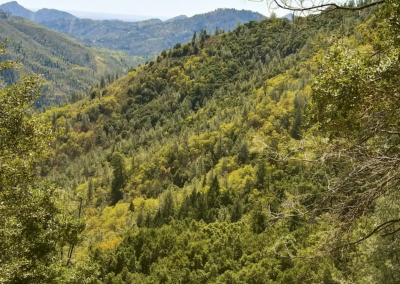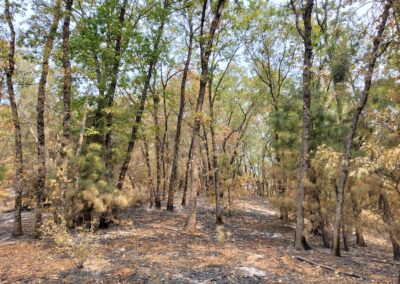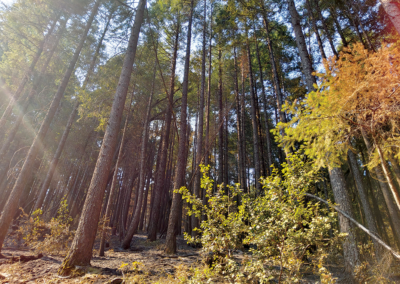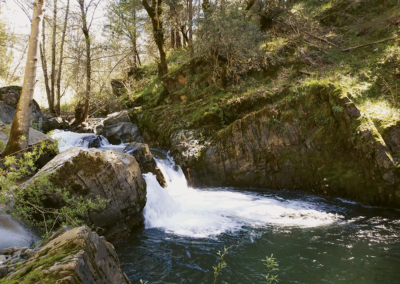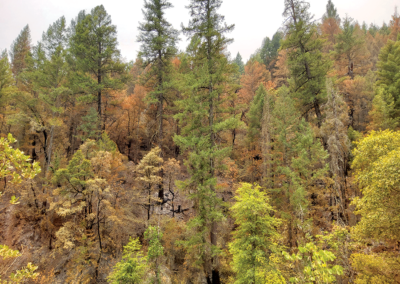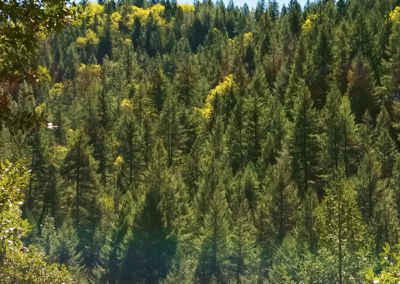
Fall 2021 ForestLife
Lightning Canyon Ranch Conserved Forever
Thanks to the generosity of Bob and Cassie Hixon, together with funding from the Wildlife Conservation Board’s Climate Adaptation and Resilience Program, the 2,098-acre Lightning Canyon Ranch was permanently conserved early this summer with Pacific Forest Trust.
This extraordinary property lies to the east of Interstate 5, between the Sacramento and McCloud River arms of Shasta Lake, in the Whiskeytown-Shasta-Trinity National Recreation Area. Encompassing the summit and slopes of Sacramento Mountain, 16 miles of creeks flow through it into the Salt Creek inlet of Lake Shasta. Given the great diversity of elevation and aspect, as well as ample water resources, this forest is rich in biodiversity and strategically located as a “best bet” for wildlife habitat resilience as California’s climate changes.
That resilience was just tested by the Salt Fire, which started near I-5 and burned through the property just after the conservation easement was granted. As fire is a natural part of California’s forest ecosystems, we know that it isn’t a matter of if a conserved property will burn, but when and how. As a result, management for resilience is built into every conservation easement we craft with our partners.
As the Salt Fire burned, we conferred with the Hixons and their forester, Bob Hutcheson of Black Fox Timber Management, to assess its impact, and to support their planning for habitat restoration.
Our first step was to do a post-fire assessment, and the photos below help tell the story of “before” and “after” this fire. Fires burn at varying intensities and with different impacts to vegetation and habitats. Low to middle intensity fire is actually a great benefit for many forest ecosystems. Such fires reduce excess fuels like small young understory trees and shrubs that have built up after a century of fire suppression. Plants that depend on fire are rejuvenated and flourish. Many trees recover from fire — oaks and older conifers with thick bark often survive as they are adapted to this fire regime. (Even dead trees nourish the soil and provide habitat for rare species like the threatened black-backed woodpecker.) At Lightning Canyon, in places where the fire burned very hot, chaparral species will come back quickly, and some conifer stands will be logged, creating new gaps with grass and shrubs that deer and other species need, and some areas will be replanted to restore conifers more quickly.
“We were all excited to have Lightning Canyon finally protected for the future, and then the Salt Fire struck! I think of the families nearby that lost their homes, and of the beautiful forest in flames,” Bob recalled. “But, within a week, deer and black bear were back eating the acorns that had fallen. Now there are fresh sprigs of green coming up. We know nature will heal itself, and, with time, Lightning Canyon’s habitats will be even richer. After all, nature is dynamic and so is conservation.”
Click to enlarge each image.
South facing slopes with chapparal burned hotter. Note buildings in the distance where the Wildland Urban Interface is invading the slopes surrounding Shasta Lake. Lightning Canyon Ranch prevents such dangerous increasing WUI development.
On eastern slopes with more exposure, conifer forest burned more, but older trees with thicker bark fared better.

